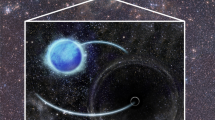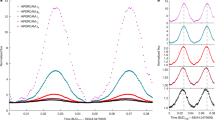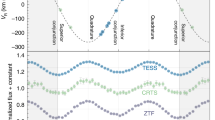Abstract
IT would be of great interest to discover a collapsed object (neutron star or black hole) as one component of a binary star system. Trimble and Thorne1 have compiled a list of fifty candidate systems from Batten's2 catalogue. These are non-eclipsing single-line spectroscopic binaries in which the unseen companion has a mass estimated to be greater than 1.4 M⊙. These unseen companions are thus too massive to be non-rotating white dwarfs (although the possibility that they are rapidly, differentially rotating white dwarfs cannot be completely excluded as Ostriker and Bodenheimer3 have shown). In principle, some of these unseen companions could be neutron stars or black holes. In most cases, including all those to be considered here, the unseen companion is less massive than the observed primary star and can be a normal main-sequence star, which is not observed simply because it is considerably less luminous than the primary. Recently, however, Gibbons and Hawking4 have presented evidence that suggests that one or more of the systems on the Trimble and Thorne list contain collapsed objects. Their argument is as follows. Let the initial binary system consist of two stars with masses M1 and M2. Let the more evolved star (M1) eject some of its mass and collapse to form a neutron star or black hole with gravitational mass MN1. The ejected mass-energy can be in the form of a shell of matter or gravitational radiation, for example. If the initial orbit is circular and the mass loss can be treated as instantaneous and spherically symmetric, then the resultant binary system (M2, MN1) will have an orbital eccentricity given by  (Note: the notation for the star masses above is not the usual notation for spectroscopic binaries.) Three of the seven systems from the Trimble and Thorne list with P<5 days were found to have e>0.08. By a comparison with short-period double-line binaries Gibbons and Hawking concluded that the probability of this occurring by chance is only 8%. This suggests that in one or more of the three systems, the eccentricity arises from a sudden mass loss and that the unseen companion is a collapsed object rather than a main-sequence star.
(Note: the notation for the star masses above is not the usual notation for spectroscopic binaries.) Three of the seven systems from the Trimble and Thorne list with P<5 days were found to have e>0.08. By a comparison with short-period double-line binaries Gibbons and Hawking concluded that the probability of this occurring by chance is only 8%. This suggests that in one or more of the three systems, the eccentricity arises from a sudden mass loss and that the unseen companion is a collapsed object rather than a main-sequence star.
This is a preview of subscription content, access via your institution
Access options
Subscribe to this journal
Receive 51 print issues and online access
$199.00 per year
only $3.90 per issue
Buy this article
- Purchase on Springer Link
- Instant access to full article PDF
Prices may be subject to local taxes which are calculated during checkout
Similar content being viewed by others
References
Trimble, V. L., and Thorne, K. S., Astrophys. J., 156, 1013 (1969).
Batten, A. H., Pub. Dom. Astrophys. Obs., 8, 8 (1967).
Ostriker, J. P., and Bodenheimer, P., Astrophys. J., 151, 1089 (1968).
Gibbons, G. W., and Hawking, S. W., Nature, 232, 465 (1971).
Lucy, L. B., and Sweeney, M. A., Astron. J., 76, 544 (1971).
Gott, III, J. R., Astrophys. J. (in the press).
Cox, J., and Guili, R., Principles of Stellar Structure (Gordon and Breach, New York, 1968).
Delhaye, J., Galactic Structure (edit. by Blaauw, A., and Schmidt, M.) (University of Chicago Press, 1965).
Plavec, M., Adv. Astron. Astrophys., 6, 201 (1968).
Hartle, J. B., and Thorne, K. S., Astrophys. J., 153, 807 (1968).
Author information
Authors and Affiliations
Rights and permissions
About this article
Cite this article
GOTT, J. Further Evidence for Collapsed Objects in Binary Star Systems. Nature 234, 342–343 (1971). https://doi.org/10.1038/234342b0
Received:
Issue Date:
DOI: https://doi.org/10.1038/234342b0
This article is cited by
-
Black Holes and Gravitational Theory
Nature (1972)
-
No Evidence for Black Holes in Eccentric Binary Systems
Nature Physical Science (1972)
-
Physical Sciences: Nature of the Secondary Component of Beta Lyrae
Nature (1972)
-
Black Holes and Binary Stars
Nature (1971)
Comments
By submitting a comment you agree to abide by our Terms and Community Guidelines. If you find something abusive or that does not comply with our terms or guidelines please flag it as inappropriate.



